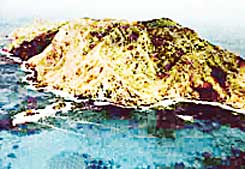It is possible to use the residents of Norfolk and Pitcairn Islands, many of whom suffer from hypertension, for research that will try to isolate the gene that causes the disease. The residents drink the same water, breathe the same air, and all eat the Anglo-Polynesian menu that is rich in cholesterol and saturated with butter and cream. News from the islands

Direct link to this page: https://www.hayadan.org.il/genlab16901.html
In the middle of the 19th century, when the number of residents of Pitcairn Island reached 200 people, there was concern that the small island, which has an area of less than 4 square kilometers, would not be able to support the growing population of the descendants of the "Bounty". The British government offered to move the residents to a larger island and the choice fell on Norfolk Island, which is 6,000 km from Pitcairn Island and 1,000 km from New Zealand. Norfolk Island is 10 times larger than Pitcairn, and most of its land is arable.
The island was discovered by Captain Cook in 1774 and from 1788 it was used as a penal colony, to which dangerous criminals from England were deported. In 1855, the British decided to concentrate all criminals in Tasmania, and the penal colony in Norfolk was closed. There are empty stone houses left on the island that were built by the prisoners as part of the hard work imposed on them.
At first the residents of Pitcairn were suspicious of the British proposal. They feared that the move to the new island, closer to the mainland, would expose their community to the wider world and weaken the close ties of its members, for all the people of Pitcairn had been, in fact, one big and united family until then.
The British government assured them that the entire island of Norfolk would be divided among the Pitcairns, and that no other settlers would arrive there. The governor of Australia, Denison, who had Norfolk under his responsibility, promised the Pitcairnians full autonomy with self-government by an elected council, and they were convinced.
On May 2, 1856, all the Pitcairns said goodbye to their island, boarded the ship "Maurishire" with their chattels and possessions, and set out on the long journey to Norfolk. Pitcairn, which for 66 years served as a home for the descendants of the rebels, remained empty.
The day the "Maurishire" landed in Norfolk, on June 8, 1856, is celebrated there to this day. The community that remained in Norfolk grew. Years later some of them returned to Pitcairn. Today the number of Pitcairn and Norfolk immigrants reaches 900 people.
For the last 150 years, the people of Norfolk have been fighting for their right to the autonomy they were promised, and do not agree to be called full Australian citizens.
The Australian government, opposed to the separatism of Norfolk, enacted a law at the end of the 19th century that prohibited the study of the Pitcairn language (a sort of lyll of pre-Victorian and Polynesian English).
The government's ambition to annex Norfolk to Australia increased when in 1970 signs of oil were discovered on the island's shores. In a referendum held at the time in Norfolk, 85% of the residents opposed the annexation. The people of Norfolk recognize that the Australian Government is responsible for their foreign affairs and security. Many of them served in the Australian Army in both world wars. On the other hand, they see themselves as a race in its own right, connected to Pitcairn Island by ties of blood, tradition and language.
Beginning at the end of the 19th century, doctors who visited Norfolk and Pitcairn noticed a very high prevalence of hypertension in the older islanders. The disease causes damage to organs such as the heart, kidneys and brain and leads to the death of tens of millions worldwide.
The causes of the disease are many, some environmental and some hereditary. Among the environmental factors are the type of diet, the composition of the drinking water, the quality of the air and the stress in everyday life. It is difficult to separate the causes of the disease and it is difficult to collect a uniform group of people for research purposes.
It seems that Norfolk Island could serve as an ideal human laboratory for such research. You can find out there the genetic connections of every descendant of the "Bounty" rebels. The residents drink the same water, breathe the same air, and all eat the Anglo-Polynesian menu that is rich in cholesterol and saturated with butter and cream.
Recently, Dr. Lynn Griffith from the University of Queensland in Australia began trying to isolate the gene responsible for hypertension. All Norfolk residents will participate in the research she is conducting. They will donate a blood sample from which the researchers will extract the DNA of the descendants of the rebels. They hope that the test will help them decipher the hereditary element of the disease. It is possible that the discovery of such a gene will lead to a revolutionary change in the treatment of hypertension. If all this does happen, the University of Queensland promised, the residents of Norfolk will receive a portion of the revenue that will come from the sale of the new treatment.
As a result of the "Rebellion on the Bounty" in 1789, great damage and even suffering and pain were caused to many. More than half of the bounty sailors and officers died as a result of events that were the result of the rebellion: some of them drowned in the sea, died of diseases, were murdered and even hanged.
212 years later, the descendants of the rebels, with the help of medical research, begin to pay humanity the debt they owe it for what their ancestors did.
